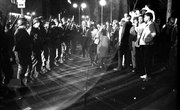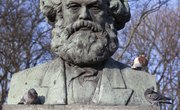F. Scott Fitzgerald’s iconic novel, “The Great Gatsby,” is a showcase for the contrasting imagery of the 1920s. Published in 1925, “The Great Gatsby” explores many of the themes reflected in life during this time of turmoil. There are many diverse choices for research paper topics covering Fitzgerald’s novel. Prominent themes concern money, alcohol, relationships and aspiring to the American dream -- factors that influenced Fitzgerald’s life as well.
Failure to Achieve the American Dream
Throughout Fitzgerald’s novel, the characters aspire to their own definitions of the American Dream. Money plays a prominent role in obtaining those dreams. Love, success, respect and wealth are incorporated into visions and life aspirations. One point to consider discussing consists of Gatsby’s idealization of Daisy compared with Daisy’s true character. Another point for consideration is the American dream of success, wealth and respect contrasted with Jay Gatsby’s amassing of wealth through illegal means (bootlegging) and how his instant affluence fails to gain him respect or a higher social standing. The hope for the dream and the despair upon not obtaining this perceived dream can be discussed, incorporating the example of Gatsby’s name change as a symbol of hope (hoping to become someone successful and wealthy) and the despair associated with his inability to change who he is at the core of his being.
The 1920s
The decade of the 1920s is often described as The Jazz Age or The Roaring '20s. The decade was rife with constant fluctuations in political, cultural and religious standards. Prohibition (the 18th Amendment passed in 1919) was a driving force behind the rise of bootleg liquor, rivalries between gangsters, police and government and the amassing of fortunes based on liquor sales. Youth, music and fashion were celebrated in this era of change. SparkNotes website says that Fitzgerald’s “The Great Gatsby” paints the 1920s as a time of empty, self-absorbed pursuits of money and pleasure. Standards once holding society in check decayed as greed, illegal activities and a disregard for morality ran rampant. Other important developments of the 1920s were the influences of the rising stock market, the presence of the KKK, rising hemlines and the role of women, the popularity of the American automobile and the attitudes of young men as influenced by World War I.
Role of Social Classes
Frederick C. Millett’s article “Analysis: 'The Great Gatsby,'” states that one of the dominant themes in the novel is change. Jay Gatsby’s rags-to-riches life is a portrait of change. As people began building fortunes, social classes began to see change. Race plays a role in these changing social classes, as do the roles of women. The nouveau riche of the era drove the economy forward with new spending power and were able to purchase the trappings of wealth; however, the “old money” fought to resist this perceived infiltration of the upper classes. East Egg was representative of the upper classes and West Egg demonstrated the rising class of self-made affluence. Jay Gatsby’s fortune is accumulated from illegal activities and, despite his wealth, he isn’t able to enter the upper echelon of society. A point to consider is the effect of social class on the relationship between Gatsby and Daisy.
The Symbols of Location
The narrator of “The Great Gatsby,” Nick Carraway, describes the locations in the novel. East and West Egg, New York, are central locations as well as symbols for old wealth and new wealth. Locations are also symbols of morality. New York represents the fast-paced, youthful, free-wheeling behavior associated with the era. Nick Carraway’s point of origin, Minnesota, represents the old standard, the morally strong, and is a place of refuge. Nick came from Minnesota to New York and in the end returns to Minnesota.
Related Articles
References
Resources
Writer Bio
Louise Harding holds a B.A. in English language arts and is a licensed teacher. Harding is a professional fiction writer. She is mother to four children, two adopted internationally, and has had small businesses involving sewing and crafting for children and the home. Harding's frugal domestic skills help readers save money around the home.











